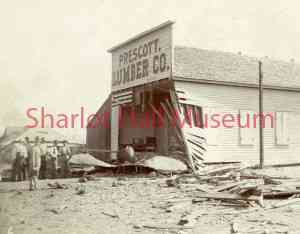By Mick Woodcock
Last week we learned about the August 16, 1898 explosion of the boiler of the Number 2 engine owned by the Santa Fe, Prescott and Phoenix Railway that killed two men and injured two others. Parts of the locomotive were thrown into town, the largest piece of which was the outside of the boiler and steam chest.
The other large piece of machinery sent airborne was an air pump. According to the newspaper, “The air-pump which landed in the middle of Cortez street, bounded about forty or fifty feet from where it struck, like a rubber ball, lighting in close proximity to a woman who was just crossing the street. Occupants of A. J. Head’s residence were badly frightened by the shrieking, singing noise of the pump as it passed over the house.”
 Smaller pieces were scattered around the north part of Prescott. A large piece of iron struck the home of Joe Calles, a local saddle maker. It went through the roof, passed through a chaise that Mrs. Calles was known to nap on, and then went on through the floor. Fortunately, Mrs. Calles was at a neighbor’s house at the time.
Smaller pieces were scattered around the north part of Prescott. A large piece of iron struck the home of Joe Calles, a local saddle maker. It went through the roof, passed through a chaise that Mrs. Calles was known to nap on, and then went on through the floor. Fortunately, Mrs. Calles was at a neighbor’s house at the time.
Iron missiles were abundant, with one burying itself in Father Quetu’s yard, another one going through a window of the public school, and a five-pound chunk coming through the roof and then the floor of Brown Brothers store, narrowly missing a man. Boiler pipe hit the edge of the roof on the Methodist church parsonage, knocking off a few shingles, before landing in the back yard. An award for furthest flight would have gone to a piece of iron reported to have struck the quarters of Colonel McCord at Fort Whipple, over a mile away from the blast.
The railroad suffered $12,000 in damage, approximately $380,000 in today’s money. Windows were blown out of passenger cars sitting in the yard and two boxcars were completely overturned. Engine Number 9 was in the roundhouse stall next to the explosion. It sustained some damage, but was stuck until the wreckage could be cleared away. The wood sides of adjacent machine shops were badly damaged with windows blown out and some machinery damaged. Another local machine shop, owned by a Mr. Williams and located near the railyards, also reportedly sustained some damage. The newspaper noted that although damage was wide spread, only men in the roundhouse were injured, despite several narrow escapes as previously noted.
yard and two boxcars were completely overturned. Engine Number 9 was in the roundhouse stall next to the explosion. It sustained some damage, but was stuck until the wreckage could be cleared away. The wood sides of adjacent machine shops were badly damaged with windows blown out and some machinery damaged. Another local machine shop, owned by a Mr. Williams and located near the railyards, also reportedly sustained some damage. The newspaper noted that although damage was wide spread, only men in the roundhouse were injured, despite several narrow escapes as previously noted.
 The next week’s newspaper reported many details relating to the explosion as well as to the deaths of Joseph Brown and F. M. Seaman, both of whom were taken to Mercy Hospital. These were described in somewhat gruesome detail. Brown was pulled, unconscious, from the building wreckage and never regained consciousness before passing. Seaman, on the other hand, was conscious until almost the end. The article also stated that they had been embalmed and that the remains would be shipped, ironically, by rail to relatives back east. A coroner’s inquest was held and it “…rendered a verdict that the deceased persons came to their death from the explosion of a boiler, the cause of the explosion being unknown.”
The next week’s newspaper reported many details relating to the explosion as well as to the deaths of Joseph Brown and F. M. Seaman, both of whom were taken to Mercy Hospital. These were described in somewhat gruesome detail. Brown was pulled, unconscious, from the building wreckage and never regained consciousness before passing. Seaman, on the other hand, was conscious until almost the end. The article also stated that they had been embalmed and that the remains would be shipped, ironically, by rail to relatives back east. A coroner’s inquest was held and it “…rendered a verdict that the deceased persons came to their death from the explosion of a boiler, the cause of the explosion being unknown.”
The reason for the explosion remained a mystery. Apparently, the steam gauge and safety valve that brought the engine in for repair had been fixed and the water level in the boiler and its pressure were at acceptable levels. Whatever the cause, the railroad indicated that it would immediately rebuild the roundhouse and that things would return to normal.
"Days Past” is a collaborative project of the Sharlot Hall Museum and the Prescott Corral of Westerners International (www.prescottcorral.org). This and other Days Past articles are also available at archives.sharlothallmuseum.org/articles/days-past-articles/1. The public is encouraged to submit proposed articles and inquiries to dayspast@sharlothallmuseum.org. Please contact SHM Research Center reference desk at 928-445-3122 Ext. 2, or via email at archivesrequest@sharlothallmuseum.org for information or assistance with photo requests.


